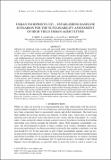| dc.contributor.author | Benis, Khadija | |
| dc.contributor.author | Gashgari, R. | |
| dc.contributor.author | Alsaati, A. | |
| dc.contributor.author | Reinhart, Christoph | |
| dc.date.accessioned | 2019-08-30T14:20:58Z | |
| dc.date.available | 2019-08-30T14:20:58Z | |
| dc.date.issued | 2018-12 | |
| dc.identifier.issn | 1755-7437 | |
| dc.identifier.issn | 1755-7445 | |
| dc.identifier.uri | https://hdl.handle.net/1721.1/122030 | |
| dc.description.abstract | Allowing for significant water savings and year-round yields, Controlled-Environment Agriculture (CEA) is oftentimes portrayed as a sustainable alternative to conventional farming, and its practice in urban areas as a food, income and employment generator is expanding worldwide. Particularly in today's fast growing cities, where economic strength is buying food security through imports, a largescale implementation of such practices should be further investigated as potential contributors - not only to food security but also to self-sufficiency - for the production of horticultural crops. However, further than quantifying the potential for food self-sufficiency of cities through urban cultivation, there is a crucial need for assessing the extent to which such scenarios are effectively more sustainable than existing supply chains. For that purpose, this paper presents the Urban Foodprints (UF) methodology, a fundamental preliminary step in the sustainability assessment of high-yield urban agriculture, consisting of collecting and integrating data on the existing supply chain, to be used as a baseline scenario in the environmental performance analysis. Through the case of Riyadh, Saudi Arabia, where harsh climatic conditions, a heavy reliance on food imports and a growing population constitute major threats to food security, the UF method is described and applied to the top four consumed horticultural crops - watermelon, tomato, onion and carrot. The environmental sustainability of high-yield urban agriculture in Riyadh is subsequently assessed for tomato, as a comparison of the resulting city's current foodprint for the crop vs. a scenario of local production in CEA urban farms. Results show that urban production in high-yield greenhouses has the potential to reduce Global Warming Potential (GWP) by 9%. However, while water savings contribute greatly to reducing irrigation-related emissions and food miles are considerably reduced, the energy needs of the greenhouses are significantly higher than the baseline. This outcome may be improved by enhancing the envelope of the farms to reduce overheating. Keywords: baseline scenario; Controlled-Environment Agriculture (CEA); sustainability assessment; Urban Foodprint; urban food system | en_US |
| dc.language.iso | en | |
| dc.publisher | WITPRESS LTD | en_US |
| dc.relation.isversionof | http://dx.doi.org/10.2495/dne-v13-n4-349-360 | en_US |
| dc.rights | Article is made available in accordance with the publisher's policy and may be subject to US copyright law. Please refer to the publisher's site for terms of use. | en_US |
| dc.source | WIT Press | en_US |
| dc.title | Urban foodprints (UF) – Establishing baseline scenarios for the sustainability assessment of high-yield urban agriculture | en_US |
| dc.type | Article | en_US |
| dc.identifier.citation | Benis, K. et al. "Urban Footprints (UF) - Establishing baseline scenarios for the sustainability assessment of high-yield urban agriculture." International Journal of Design & Nature and Ecodynamics 13, 4 (December 2018): 349-360 © 2018 WITPRESS LTD | en_US |
| dc.contributor.department | Massachusetts Institute of Technology. Department of Architecture | en_US |
| dc.relation.journal | International Journal of Design & Nature and Ecodynamics | en_US |
| dc.eprint.version | Final published version | en_US |
| dc.type.uri | http://purl.org/eprint/type/JournalArticle | en_US |
| eprint.status | http://purl.org/eprint/status/PeerReviewed | en_US |
| dc.date.updated | 2019-08-08T14:47:03Z | |
| dspace.date.submission | 2019-08-08T14:47:05Z | |
| mit.journal.volume | 13 | en_US |
| mit.journal.issue | 4 | en_US |
